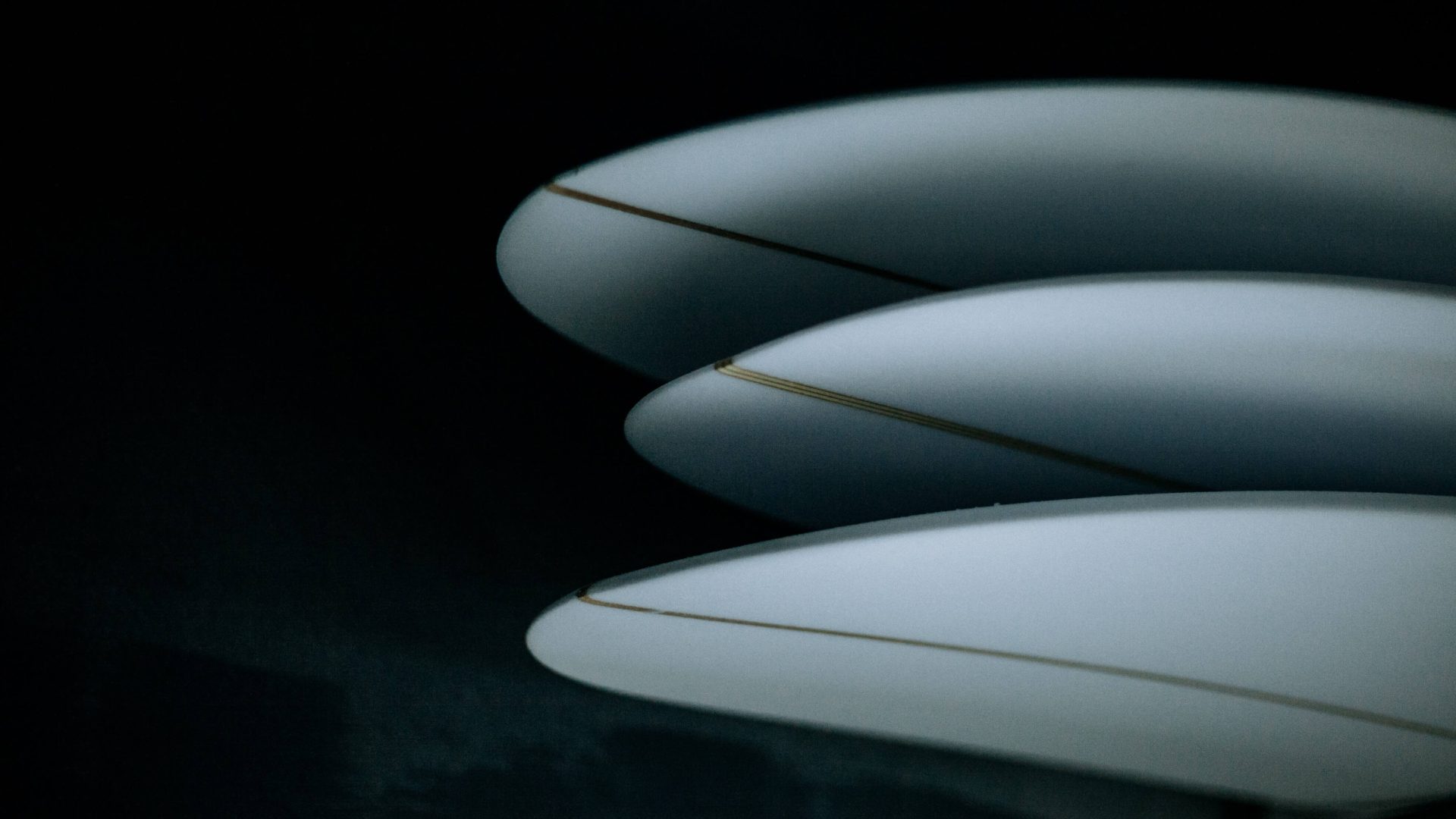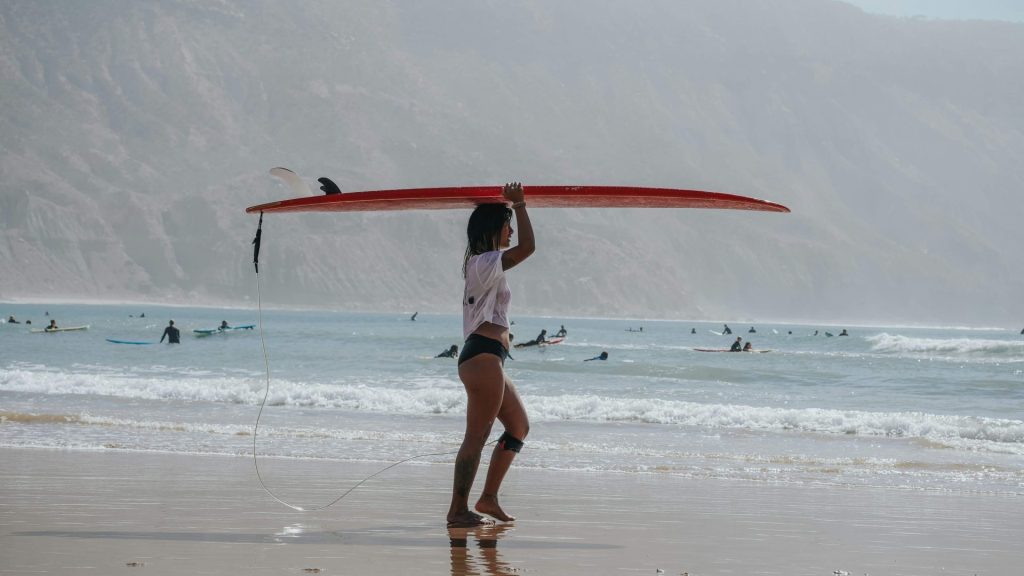The 6 Surfboard Rail Shapes Explained

We all know what surfboard rails are, but do we know all the types of surfboard rail shapes.
A slight change in the surfboard rail shapes can vastly impact your ride and popup on any wave, big or small!
Let's get into discussing all the surfboard rail shapes you can expect to see.
What Are The Surfboard Rail Shapes?
Surfboard rail shapes vary and include soft full rails for stability and ease of use, hard knifey rails for manoeuvrability and a range of intermediate options to suit different surfing styles and wave conditions.
Surfboard Rail Shapes Explained
Surfboard rail shapes play a crucial role in your board's performance no matter what surfboard type you have.
The rails are the edges of your surfboard, and their shape impacts how it glides on the water and responds to your commands.
It's also important to know your surfbaord rail shapes when repairing your surfboard as different repair tactics will be needed for different rails.
The 6 Surfboard Rail Shapes
- Full Rails: These are thicker, offering stability and buoyancy. Ideal for beginners, they provide a balanced feel.
- Hard Rails: Thin and sharp, these allow for precise manoeuvrability. They're great for advanced surfers.
- Soft Rails: Rounded, these offer a forgiving feel and smoother turns. They're common on longboards.
- Tucked Rails: Similar to soft rails but with a sharper edge. They provide a balance between stability and manoeuvrability.
- Boxy Rails: Square in shape, they maximise stability but might sacrifice some agility.
- Pinched Rails: Narrow and sensitive, they make the board more responsive to your movements.
Understanding Rail Foils
Besides the rail shape, the rail foil is equally important.
Rail foils are the cross-sectional profiles of your rails, affecting water flow and performance. They can be either concave, convex, or flat, each offering distinct advantages in various surf conditions.
Hard Rails vs Soft Rails Comparison
| Rail Type | Performance | Best for... |
| Hard Rails | Precise control | Advanced surfers, big waves, shortboards |
| Soft Rails | Forgiving ride | Beginners, small waves, longboards |
Exploring Soft Surfboard Rails
Soft rails, also known as 50/50 rails, are common on longboards and some funboards.
Their rounded shape ensures a forgiving ride, making them suitable for beginners. Soft rails provide smoother, flowing turns, and their buoyancy helps maintain stability.
Benefits of Soft Rails
- Forgiveness: Soft rails make it easier to catch waves and maintain balance, perfect for those learning to surf.
- Smooth Turns: The rounded shape offers graceful, sweeping turns, enhancing the riding experience.
- Stability: Soft rails provide a stable platform for surfers to build confidence.
Exploring Hard Surfboard Rails
Hard rails, often found on shortboards, are the opposite of soft rails. They have a thin, sharp edge that provides precise control and responsiveness, making them the choice of advanced surfers.
Benefits of Hard Surfboard Rails
- Precision: Hard rails allow advanced surfers to execute sharp turns with accuracy.
- Versatility: Ideal for shortboards, they excel in various wave conditions.
- Agility: Their thin shape enhances the board's manoeuvrability, responding quickly to rider input.
Surfboard Rail Thickness
Surfboard rail thickness refers to the width or depth of the rail.
Thicker rails offer buoyancy and stability, while thinner rails enhance agility but might reduce overall stability.
Rail/Wave Interactions
Your surfboard's rail shape interacts with wave conditions.
For instance, hard rails are well-suited for powerful waves that require precise manoeuvres, while soft rails are preferable in smaller, mellower waves for a more forgiving experience.
Surfboard Rail Shapes and Water Flow
The surfboard rail shapes affect how water flows along the board.
Sharp hard rails cut through the water, offering speed and precision, while rounded soft rails create smoother water flow, promoting stability.
With an understanding of surfboard rail shapes and their impact, you can choose the right board for your skill level and the wave conditions, enhancing your surfing experience.
Surfboard Rail Foil
The rail foil, or rail configuration, determines the rail's cross-sectional shape. This profile directly affects how the rail interacts with the water, impacting the board's performance. Let's explore some common rail foils:
50/50 Rails
A 50/50 rail foil means the bottom and top edges of the rail are equally rounded. This type of foil offers a balanced performance with good stability, making it ideal for longboards and beginner-friendly boards.
60/40 Rails
In a 60/40 rail foil, the bottom edge is sharper than the top. This creates a more forgiving and smooth ride, which is great for versatile surfboards that can handle a range of conditions.
80/20 Rails
An 80/20 rail foil features a pronounced bottom edge. This configuration enhances manoeuvrability and responsiveness, ideal for more aggressive turns and advanced riders.
Surfboard Rail Shapes: 50/50 Rails vs 60/40 Rails
| Aspect | 50/50 Rails | 60/40 Rails |
|---|---|---|
| Stability | High stability | Balanced stability |
| Maneuverability | Moderate maneuverability | Good maneuverability |
| Best for | Beginners | Versatile surfers |
| Performance | Basic turns and cruising | Wide range of conditions |
| Control | Easy to control | Responsive control |
| Wave Types | Small waves | Various wave types |
| Skill Level | Entry-level | Intermediate |
This table provides a comparison between 50/50 rails and 60/40 rails, highlighting their characteristics and suitability for different surfing preferences and conditions.
Choose the rail shape that aligns with your skill level and the type of waves you want to ride for an optimal surfing experience.
Edged Rails
Edged rails have a sharper bottom edge compared to rounded rails. They are well-suited for advanced surfers who want precise control over their board.
Surfboard Down Rails
Down rails are a variation of hard rails that run down from the deck to the bottom of the board. They offer exceptional control and are commonly found on high-performance shortboards.
Eggy, Pinched, and Knifey Surfboard Rails
These are specific variations of rail shapes:
- Eggy Rails: Rounded and forgiving, providing a smooth ride, often found on longboards.
- Pinched Rails: Narrow and sensitive, offering greater responsiveness and precision for shortboards.
- Knifey Rails: Extremely thin and sharp, designed for expert surfers for radical manoeuvres.
Beveled or Chined Surfboard Rails
Beveled or chined rails feature flat sections along the bottom edge of the rail, creating lift and preventing the rail from catching the water. They enhance speed and manoeuvrability.
Surfboard Rail Foil and Transitions
The transition points where the foil changes can have a significant impact on the board's performance, affecting speed and responsiveness.
Surfboard Rail Channels
Rail channels are grooves or concaves in the rail's surface, altering water flow and providing added stability. They are commonly found on high-performance shortboards.
Surfboard Rail Bands
Rail bands are colour-coded bands along the rail that help surfers identify the best place to grip the board for various manoeuvres.

Surfboard Rail Shapes Definitions
- Rail Foil: The cross-sectional shape of the rail, influencing water flow and board performance.
- 50/50 Rails: Equally rounded top and bottom edges, providing balance and stability.
- 60/40 Rails: A rail foil with a sharper bottom edge, offering a smooth yet manoeuvrable ride.
- 80/20 Rails: Features a pronounced bottom edge for enhanced manoeuvrability and responsiveness.
- Edged Rails: Rails with a sharper bottom edge for precise control.
- Down Rails: A variation of hard rails that run from the deck to the board's bottom.
- Eggy Rails: Rounded and forgiving rail shape ideal for a smooth ride on longboards.
- Pinched Rails: Narrow and responsive rails suited for shortboards.
- Knifey Rails: Extremely thin and sharp rails designed for advanced surfers.
- Beveled or Chined Rails: Rails with flat sections for added lift and speed.
- Rail Channels: Grooves or concaves on the rail's surface, altering water flow.
- Rail Bands: Colour-coded bands along the rail for grip positioning.
Best Surfboard Rail Shapes
Choosing the right surfboard rail shapes and nose shapes is essential for achieving your desired performance. Let's explore some of the best rail shapes for various surfing styles:
1. 50/50 Rails
- Best For: Beginners and longboarders.
- Why: The balanced 50/50 rail shape provides stability, making it easier for new surfers to catch waves and maintain control.
2. 60/40 Rails
- Best For: Versatile surfers who enjoy a range of conditions.
- Why: The 60/40 rail configuration offers a balance between stability and maneuverability, making it suitable for all-around performance.
3. Down Rails
- Best For: Expert surfers looking for precise control.
- Why: Down rails provide advanced surfers with the ability to execute radical maneuvers and high-performance tricks.
4. Eggy Rails
- Best For: Longboard enthusiasts.
- Why: Rounded eggy rails deliver a forgiving and smooth ride, making them ideal for those who appreciate the classic longboard feel.
5. Pinched Rails
- Best For: Shortboarders seeking high responsiveness.
- Why: Pinched rails are perfect for those who want quick and sharp turns, as they offer greater responsiveness and precision.
6. Beveled Rails
- Best For: Speed and maneuverability.
- Why: Beveled rails create lift and reduce water resistance, promoting high-speed maneuvers and quick transitions.
7. Knifey Rails
- Best For: Advanced surfers seeking radical performance.
- Why: Knifey rails, with their thin and sharp profile, are perfect for executing advanced tricks and maneuvers with precision.
Remember that the best surfboard rail shapes for you depends on your skill level, preferred surfing style, and the types of waves you'll be riding.
All surfboard rail shapes have unique advantages, so it's essential to match it with your abilities and preferences for an optimal surfing experience.
Summing It Up: What To Do Now
There you go! Surfboard rail shapes are now a topic you are informed upon ready to implement to yourself and your surf gang! If you want to now progress onto learning about the surfboard tail here is a helpful video.
If your interested in learning more about surfing discover our many guides that will inform you on your surfing journey. Don't forget to follow us on Facebook & Instagram to stay informed on our amazing surf shots and stories shared from surf creators around the world!
Frequently Asked Questions
What do boxy rails do on a surfboard?
Boxy rails provide stability, making the surfboard suitable for beginners and small waves. They offer a secure and forgiving ride.
What does 60/40 surfboard rail shapes mean?
60/40 rails have a 60% volume on the top and 40% on the bottom. They balance stability and manoeuvrability, making them versatile for various conditions.
What is the difference between thin and thick rails?
Thin rails are more sensitive and suitable for experienced surfers, providing precise control. Thick rails are forgiving and stable, perfect for learners.
What do 50/50 surfboard rail shapes mean?
50/50 rails have an even distribution of volume on the top and bottom. They offer high stability, making them ideal for novice surfers.
What is the difference between hard rail and soft rail?
Hard rails have sharper edges and provide better control for advanced surfers. Soft rails are rounder and offer more forgiveness for beginners.
What are pinched rails?
Pinched rails are narrower towards the tail, enhancing manoeuvrability and control on the wave. They're favoured for high-performance surfing.


